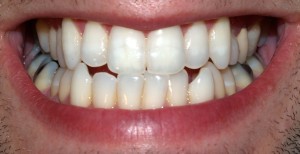What You Need to Know About Dental Biometrics

Dental biometrics is the use of dental radiography (x-rays) in the identification of otherwise unidentifiable human remains. This forensic use has earned dental biometrics great fame, as its use has appeared as much in crime novels and television shows as in the real world of the crime lab. Tooth size, tooth contours and shapes, distance between teeth, and crowns, fillings, and other dental work all factor into the positive identification of persons from mere skeletal remains, or in cases of corpses badly burnt or disfigured. Thus biometric analysis of dentistry is a last resort method of identification when other more usual methods fail.
Modern Methods of Computer-aided Dental Biometrics
Before the development of mathematical algorithms and image sharpening and extraction methods that allowed highly reliable analysis of dental radiographs on computer, the process was more slow and tedious. The basics still apply: two radiographs of equivalent areas of the victim’s and a proposed candidate’s teeth must be compared meticulously. To do this, pre-existing records, probably from the match candidate’s dentist, must be obtained, and a new post-mortem image must be taken of the remains of the victim’s teeth. Written dental records will also contribute to the identification. In rare cases where an assailant has lost a tooth or crown or has left bite marks on a victim, dental biometrics can also be used to track down the killer.
Read More: Biometric Security Is Everywhere
There are four steps necessary in using modern technology to perform accurate biometric analysis of dentistry:
- A dental radiograph must be obtained from the victim’s remains
- That image must be pre-processed to enhance visibility of image features
- Features must be individually extracted from the full x-ray
- A pre-existing image that has undergone the same process (steps one through three above) must be compared with the extracted features to seek a match
Image Pre-processing
Once a radiograph exists and has been uploaded into the software system, some initial processing is necessary. Radiographs may be one of three types: bitewing, covering mainly the above gum section of teeth; periapical, showing also the full root; or Panoramic, giving the broad view of teeth and jaws. Periapical is preferred for its close up view with all the tooth included. The software will take out unneeded background and focus up-close on the particular tooth, dental work, etc. that is in question.
Feature Extraction
A biometric is a physical feature or behavior that is measurable. Behaviors such as handwriting styles, gait of walk, and voice quality, along with characteristics like eye retinas, fingerprints, or the shape of a tooth are biometrics. Dental biometric software shades teeth, bone, dental work, and background differently so as to help isolate individual items and features for later comparison. Size, shape, and position of teeth relative to other nearby teeth are targeted along with crowns, fillings, and all artificial dental fixtures. By increasing contrast and finding edges, the software works at isolating each important element. Binary distinction often works best for dental work, whereas a three-way color scheme is usually used for teeth.
Read More: Why Ears Are the Future of Biometrics
Feature Matching
Pre- and post- mortem radiographs must now be carefully compared. A good software program can compute the relative alikeness or difference between database stored images and present them in number form. Size, distance measured between objects, and faltness vs. peakedness are taken into account. The degree of skewing of the pre-death x-ray away from the post-death x-ray will determine if a match is had. As a person’s teeth is constantly changing, it cannot be expected to ever obtain a 100% match, but matches that are within a narrow margin of skewing are “counted as” matches.
Conclusion
Dental biometrics is an old but now revolutionized science that continues to aid in the identification of unknown human remains. By pre-processing radiographs, extracting desired features, and comparing pre- and post- mortem snapshots of a person’s teeth and dental work, identification is often possible where otherwise it would not be.
 Author Bio: This post comes courtesy of Sarah, a writer at the Underwood Dental blog. You can find more of her writing on that blog, and at various other outlets on the web.
Author Bio: This post comes courtesy of Sarah, a writer at the Underwood Dental blog. You can find more of her writing on that blog, and at various other outlets on the web.










Hmm. Now I know a lot about dental biometrics 😉 Thanks for this article. It was really helpful.